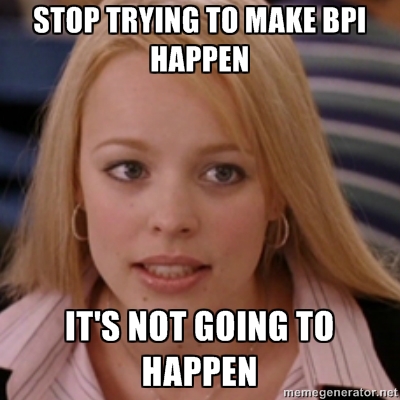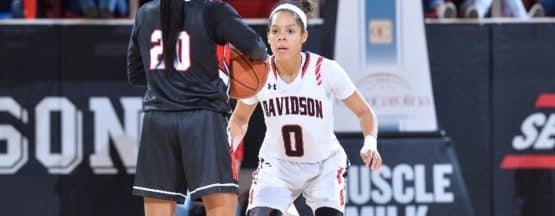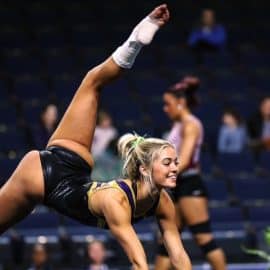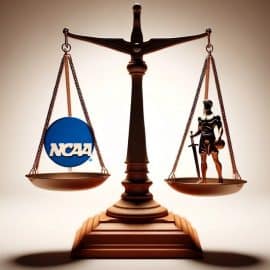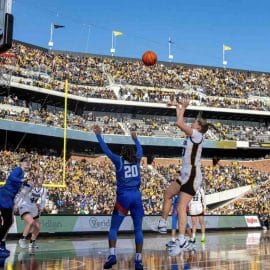When you sit down to watch any college basketball game this time of year, it’s a guarantee that you’ll be bombarded with talk about the bubble, the S-curve, and Joe Lunardi’s “Last 4 In.” In recent years, the NCAA has improved their transparency tremendously by releasing the RPI “Nitty Gritty” report and Team Sheets that the committee uses when looking at teams. Sites such as CBS Sports Team Comparison and WarrenNolan.com are great resources for looking at the resumes of given teams. ESPN his highly biased towards their BPI metric (which I will address momentarily) and sites like KenPom.com are good for efficiency metrics but are not used by the Committee. Every year, there is a lot of criticism about the bracket, who got in, who didn’t, and why one region is seemingly more difficult than the rest. Here’s an overview of how the Selection Committee puts together the 68-team field.
Selecting the Field
Of the 68 teams in the field, 32 teams receive automatic bids for winning their conference tournament championship. For the first time ever, this year the Ivy League will hold a conference tournament with the top four teams qualifying. Previously, the regular season champion was awarded the League’s automatic bid. This leaves 36 At-Large bids that the Committee awards. This is the primary task of the Selection Committee – deciding who are the 36 best teams in the country that did not receive an automatic bid. To determine these teams, the Committee has a complicated voting procedure that would take too long to explain here. You can read more about it.
The Committee spends most of their time determining who the 36 At-Large teams are that should be in the field. The Committee uses a variety of criteria when evaluating whether or not a team should be in the field. One of the big discussions in recent years, with the emergence of other rankings systems, has been the outdated nature of the RPI. However, RPI is not the be-all-end-all of a resume. It seems like every year, a mid-major school with an RPI in the 30s is left out while major conference schools with RPIs in the 60s make it into the field. From past decisions the Committee has made, Who You Beat (quality wins), Where You Played Them (road/neutral wins), and Non-Conference Strength of Schedule were more important than computer numbers like the RPI. The Committee does not heavily weight conference record, so when you see people arguing for teams to get in based on their conference record, take it with a grain of salt. That being said the RPI does shape the lens through which resumes are viewed. When one talks of “Top 50 wins” or “sub-100 losses” those are numbers based on where a team stands in the RPI. A few years ago, ESPN developed the BPI (Basketball Power Index) to provide an alternative to the RPI. However, the Selection Committee does not use BPI rankings, so any time you see ESPN mention a BPI ranking or a team’s record against the “BPI Top 50” it can be ignored.
(credit to @bigtengeeks for the meme)
Seeding
After the Committee selects the 36 At-Large teams, they are added to the list of 32 Conference Champions. The Committee takes the 68 teams and places them in order, 1 to 68 to create a “True Seed” list. After the True Seed list is developed, teams are placed on an S-curve in order of the list to equally weight the bracket. An example S-curve of the top 16 could look like this:
1. Baylor – 2. Villanova – 3. Florida St – 4. North Carolina
8. Kansas – 7. Louisville – 6. Gonzaga – 5. Butler
9. Kentucky – 10. WVU – 11. Arizona – 12. Cincinnati
16. UCLA – 15. Virginia – 14. Creighton – 13. Oregon
On the S-curve, teams are grouped in lines of four, as they will be split among the four different regions on the bracket. After the S-curve is developed, the Committee moves on to placing teams in the bracket.
Bracketing
The NCAA has established certain rules and guidelines for bracketing that the Committee generally sticks to when placing teams in the field. The important thing to note here is that the 68-team field is already decided well before teams are placed onto the bracket. Seeds are not determined up until this point either, so the Committee does not take seeding or potential matchups into consideration when selecting the 36 At Large teams. Here are some of the basic rules for bracketing:
– The first 3 teams from a conference will be placed into different regions.
– Unless a conference has more than 8 teams in the field, there shall not be more than 2 teams from a conference in a region.
– Unless a conference has more than 8 teams in the field, teams from the same conference shall not meet until the Regional Final (Elite 8). (This rule has been relaxed in recent years and the Committee has made an exception for conference opponents that only faced each other once in the regular season.)
The Committee tries to avoid matching teams from the same conference in the early rounds, but in some cases it is unavoidable. The Committee also tries to avoid giving higher seeded teams a “home crowd disadvantage” if possible. Therefore, as the committee begins to place teams into the bracket, they will begin by moving teams around within the same seed line. In the example above, Louisville could not be placed into the same region as Florida St or North Carolina because they play in the same conference, so the Committee would switch Louisville and Kansas on the 2-seed line. The Committee is also allowed to move a team up or down 1 seed line from their “true seed line” in order to fit with the bracketing rules (though this has happened less frequently in recent years as the Committee has been more interested in sticking to their “true seed” order).
Additionally, when bracketing, the Committee places a heavier weight on travel distance than any other factor. The top four seeds are assigned to the region with the Regional Finals closest to their campus. From the example above, Baylor would go to the Midwest (Kansas City), Villanova to the East (New York City), Florida St to the South (Memphis) and UNC to the remaining bracket, the West (San Jose). Those teams seeded on lines 2-4 are similarly slotted into the closest regional final to their campus, provided it does not violate any of the conference matchup requirements listed above.
Once the top 16 teams are placed in the bracket (seed lines 1-4) they are assigned first and second round venues closest to their campus and/or area of interest. Generally teams are sent to the closest host city, but in rare cases changes are made. For instance in 2015 Maryland was sent to Columbus and Notre Dame was sent to Pittsburgh because Columbus was a Big 10 city and Pittsburgh was an ACC city even though Pittsburgh was closer to College Park and Columbus was closer to South Bend. Teams are awarded host sites based on their position on the S-curve. Since only 2 teams can be slotted per site, it is possible that teams on the 3 and 4 seed lines are sent to sites farther away from their campus. From there, the rest of the teams are placed into the bracket one seed line at a time. The first priority is avoiding conference interactions with the second priority being sending teams to the closest venue to their campus (based on which “pod” they fall into where the top team in that pod was sent).
Joe Lunardi Isn’t All-Knowing
As the calendar ticks down towards Selection Sunday, one of the phrases you’ll hear is “this win puts them in” or “this loss knocks them out.” While wins and losses down the stretch tend to get over-stated, the Committee will look at a team’s overall body of work when considering them for one of the 36 At-Large spots. Due to this, a team like Pitt, which has been downright terrible over the last few weeks, still is hovering right around the bubble because of their 3 Top 50 wins (2 against teams in the Top 20) and 5 Top 100 wins. Those are among the best marks of any team currently in the bubble picture.
However, when it comes down to the teams on the bubble, at least this year, you can find a compelling reason to keep most teams out of the tournament. Therefore, when any bracketologist, whether it’s Joe Lunardi, Jerry Palm, or someone else says “this is one of the last 4 in” they are basing it on a judgement call that they personally are making. This is one of the beauties of the Committee. Each Committee member has their own preferences. One member might think that big wins are more important than bad losses. Another might care more about a team proving they can win away from their home gym and be care more about road/neutral court wins. When the committee comes together to vote, each of these interests gets a voice, but is not predominant in the decision-making. However, when a singular bracketologist (whether it’s Joe, Jerry or me sitting at home with an Excel sheet) looks at two resumes side-by-side, you’re inevitably going to have your own personal biases about what you think is most important.
There are some questions that are simply impossible to answer. For instance – should a team with a poor record against the top teams but no bad losses get into the tournament over a team with good wins but also bad losses? ((example from this year))
This is where your personal biases come into play and why it is difficult to accurately predict what the Committee is going to do. The folks at The Bracket Project keep track of bracket predictions from a number of bracketologists (their last Bracket Matrix contained over 100 bracket predictions). They also have been “scoring” bracket predictions for the last 11 years. Joe Lunardi currently ranks 22nd out of 88 bracketologists who have been in the Matrix at lest 3 years. So when someone on ESPN says that Joe Lunardi is hardly ever wrong, you should probably laugh. The issue with Lunardi is that also being employed by ESPN, his job is not just to predict the bracket but to add to the “drama” of the season (and thus bring in more ratings). Therefore, ESPN uses Lunardi’s rankings to promote every game as a make-or-break game for a team, whether it be to stay “in” the tournament, to play their way in, or to fall off the 1-seed line. In reality, as I mentioned before, the Committee is more focused on the overall “body of work.”
Hopefully now you have a little better understanding of how the Field of 68 is selected and placed into the bracket – and why you should always take Joe Lunardi with a grain of salt.
Add The Sports Daily to your Google News Feed!
